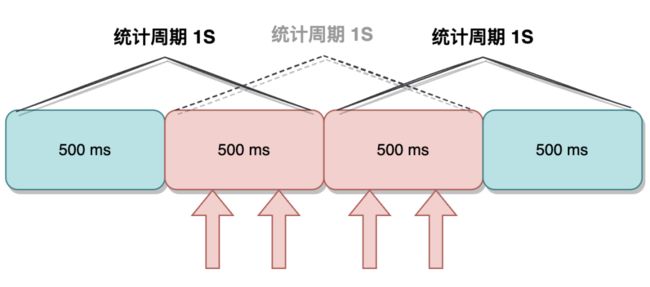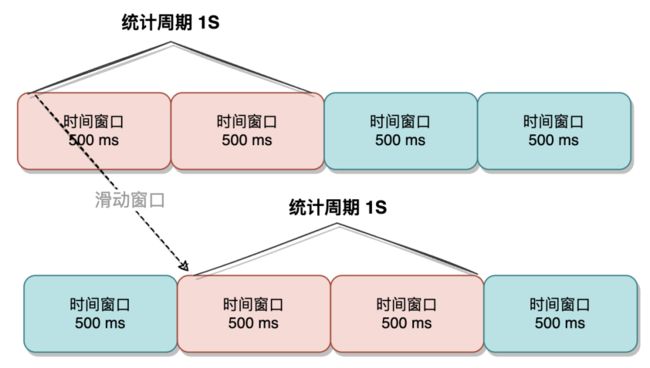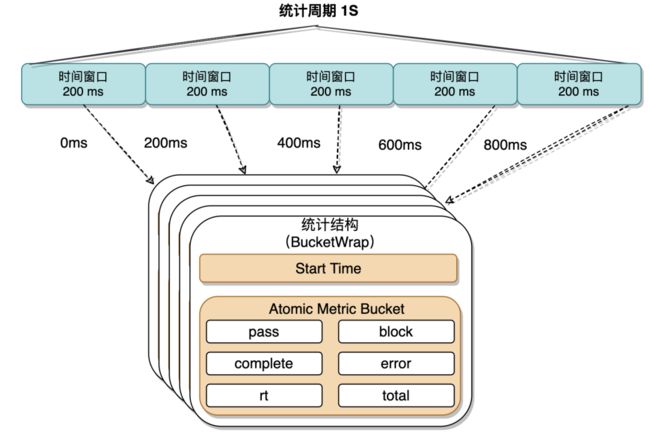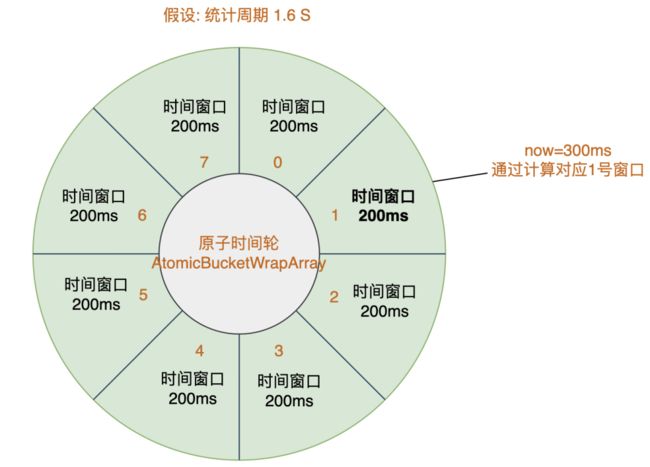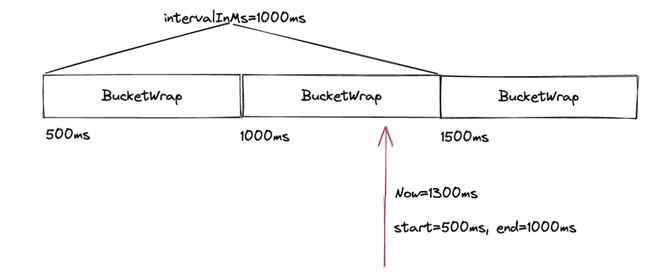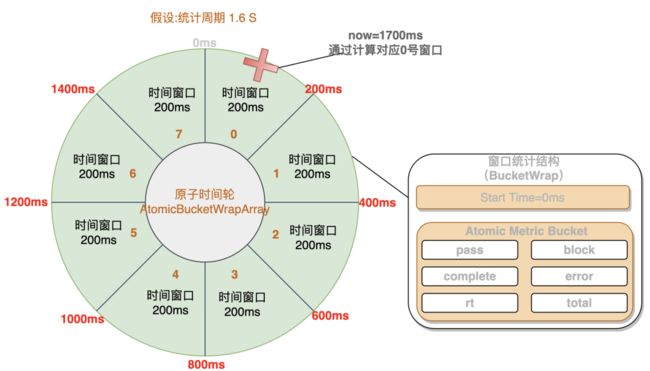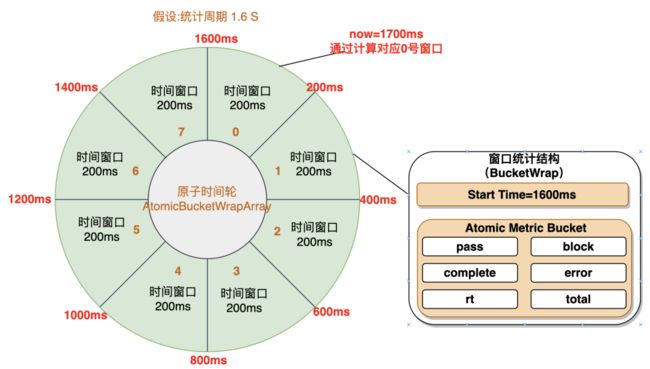Sentinel Go-毫秒级统计数据结构揭秘
01
背景介绍
Aliware
随着微服务的流行,服务和服务之间的稳定性变得越来越重要。在 2020 年,Sentinel 社区推出 Sentinel Go 版本,朝着云原生方向演进。Sentinel Go 是一个流量治理组件,主要以流量为切入点,从流量路由、流量控制、流量整形、熔断降级、系统自适应过载保护、热点流量防护等多个维度来帮助开发者保障微服务的稳定性。
无论是流量控制还是熔断降级,实现的核心思想都是通过统计一段时间内的指标数据(请求数/错误数等),然后根据预选设定的阈值判断是否应该进行流量管控
那么如何存储并统计这一段时间内的指标数据则是核心关键,本文将揭秘 Sentienl-Go 是如何实现的毫秒级指标数据存储与统计。
02
固定窗口
Aliware
在正式介绍之前,先简单介绍一下固定窗口的算法(也叫计数器算法)是实现流量控制比较简单的一种方式。其他常见的还有很多例如滑动时间窗口算法,漏桶算法,令牌桶算法等等。
固定窗口算法一般是通过原子操作将请求在统计周期内进行累加,然后当请求数大于阈值时进行限流。
实现代码:
var (
counter int64 //计数
intervalMs int64 = 1000 //窗口长度(1S)
threshold int64 = 2 //限流阈值
startTime = time.Now().UnixMilli() //窗口开始时间
)
func main() {
for i := 0; i < 10; i++ {
if tryAcquire() {
fmt.Println("成功请求", time.Now().Unix())
}
}
}
func tryAcquire() bool {
if time.Now().UnixMilli()-atomic.LoadInt64(&startTime) > intervalMs {
atomic.StoreInt64(&startTime, time.Now().UnixMilli())
atomic.StoreInt64(&counter, 0)
}
return atomic.AddInt64(&counter, 1) <= threshold
}固定窗口的限流在实现上看起来比较简单容易,但是也有一些问题,最典型的就是“边界”问题。
如下图:统计周期为 1S,限流阈值是 2 的情况下,假设 4 次请求恰好“跨越”了固定的时间窗口,如红色的 1SS 时间窗口所示会有四次请求,明显不符合限流的预期。
03
滑动时间窗口
Aliware
在滑动时间窗口算法中可以解决固定窗口算法的边界问题,在滑动窗口算法中通常有两个比较重要的概念
统计周期:例如想限制 5S 的请求数不能超过 100 次,那么 5S 就是统计周期
窗口(格子)的大小:一个周期内会有多个窗口(格子)进行指标(例如请求数)的统计,长度相等的统计周期,格子的数量越多,统计的越精确
如下所示:统计周期为 1S,每个周期内分为两个格子,每个格子的长度是 500ms。
在滑动窗口中统计周期以及窗口的大小,需要根据业务情况进行设定。
统计周期一致,窗口大小不一致:窗口越大统计精准度越低,但并发性能好,越小:统计精准度越高,并发性能随之降低;
统计周期不一致,窗口大小一致:周期越长抗流量脉冲情况越好。
04
统计结构
Aliware
下面将详细介绍 Sentinel-Go 是如何使用滑动时间窗口高效的存储和统计指标数据的。
01
窗口结构
在滑动时间窗口中时间很重要。每个窗口(BocketWrap)的组成是由一个开始时间和一个抽象的统计结构:
type BucketWrap struct {
// BucketStart represents start timestamp of this statistic bucket wrapper.
BucketStart uint64
// Value represents the actual data structure of the metrics (e.g. MetricBucket).
Value atomic.Value
}开始时间:当前格子的的起始时间
统计结构:存储指标数据,原子操作并发安全
如下图:统计周期 1S,每个窗口的长度是 200ms。
指标数据:
pass: 表示到来的数量,即此刻通过 Sentinel-Go 规则的流量数量
block: 表示被拦截的流量数量
complete: 表示完成的流量数量,包含正常结束和异常结束的情况
error: 表示错误的流量数量(熔断场景使用)
rt:单次请求的 request time
total:暂时无用
02
原子时间轮
如上:整个统计周期内有多个时间窗口,在 Sentinel-Go 中统计周期是由 slice 实现的,每个元素对应一个窗口。
在上面介绍了为了解决边界问题,滑动时间窗口统计的过程需要向右滑动。随时时间的推移,无限的向右滑动,势必会让 slice 持续的扩张,导致 slice 的容量“无限”增长。
为了解决这个问题,在 Sentinel-Go 中实现了一个时间轮的概念,通过固定 slice 长度将过期的时间窗口重置,节省空间。
如下:原子时间轮数据结构
type AtomicBucketWrapArray struct {
// The base address for real data array
base unsafe.Pointer // 窗口数组首元素地址
// The length of slice(array), it can not be modified.
length int // 窗口数组的长度
data []*BucketWrap //窗口数组
}初始化
1: 根据当前时间计算出当前时间对应的窗口的 startime,并得到当前窗口对应的位置
// 计算开始时间
func calculateStartTime(now uint64, bucketLengthInMs uint32) uint64 {
return now - (now % uint64(bucketLengthInMs))
}
// 窗口下标位置
idx := int((now / uint64(bucketLengthInMs)) % uint64(len))2:初始化窗口数据结构(BucketWrap)
for i := idx; i <= len-1; i++ {
ww := &BucketWrap{
BucketStart: startTime,
Value: atomic.Value{},
}
ww.Value.Store(generator.NewEmptyBucket())
ret.data[i] = ww
startTime += uint64(bucketLengthInMs)
}
for i := 0; i < idx; i++ {
ww := &BucketWrap{
BucketStart: startTime,
Value: atomic.Value{},
}
ww.Value.Store(generator.NewEmptyBucket())
ret.data[i] = ww
startTime += uint64(bucketLengthInMs)
}3:将窗口数组首元素地址设置到原子时间轮
// calculate base address for real data array
sliHeader := (*util.SliceHeader)(unsafe.Pointer(&ret.data))
ret.base = unsafe.Pointer((**BucketWrap)(unsafe.Pointer(sliHeader.Data)))如果对unsafe.Pointer和slice熟悉的同学,对于这段代码不难理解。这里通过unsafe.Pointer 将底层 slice 首元素(第一个窗口)地址设置到原子时间轮中。这么做的原因主要是实现对时间轮中的元素(窗口)进行原子无锁的读取和更新。
窗口获取&窗口替换
如何在并发安全的情况下读取窗口和对窗口进行替换(时间轮涉及到对窗口更新操作)
代码如下:
// 获取对应窗口
func (aa *AtomicBucketWrapArray) get(idx int) *BucketWrap {
// aa.elementOffset(idx) return the secondary pointer of BucketWrap, which is the pointer to the aa.data[idx]
// then convert to (*unsafe.Pointer)
if offset, ok := aa.elementOffset(idx); ok {
return (*BucketWrap)(atomic.LoadPointer((*unsafe.Pointer)(offset)))
}
return nil
}
// 替换对应窗口
func (aa *AtomicBucketWrapArray) compareAndSet(idx int, except, update *BucketWrap) bool {
// aa.elementOffset(idx) return the secondary pointer of BucketWrap, which is the pointer to the aa.data[idx]
// then convert to (*unsafe.Pointer)
// update secondary pointer
if offset, ok := aa.elementOffset(idx); ok {
return atomic.CompareAndSwapPointer((*unsafe.Pointer)(offset), unsafe.Pointer(except), unsafe.Pointer(update))
}
return false
}
// 获取对应窗口的地址
func (aa *AtomicBucketWrapArray) elementOffset(idx int) (unsafe.Pointer, bool) {
if idx >= aa.length || idx < 0 {
logging.Error(errors.New("array index out of bounds"),
"array index out of bounds in AtomicBucketWrapArray.elementOffset()",
"idx", idx, "arrayLength", aa.length)
return nil, false
}
basePtr := aa.base
return unsafe.Pointer(uintptr(basePtr) + uintptr(idx)*unsafe.Sizeof(basePtr)), true
}获取窗口:
在 get func 中接收根据当前时间计算出的窗口对应下标位置
根据下标位置在 elementOffset func 中,首先将底层的 slice 首元素地址转换成 uintptr,然后将窗口对应下标*对应的指针字节大小即可以得到对应窗口元素的地址
将对应窗口地址转换成时间窗口(*BucketWarp)即可
窗口更新:
和获取窗口一样,获取到对应下标位置的窗口地址,然后利用 atomic.CompareAndSwapPointer 进行 cas 更新,将新的窗口指针地址更新到底层数组中。
03
滑动窗口
在原子时间轮中提供了对窗口读取以及更新的操作。那么在什么时机触发更新以及如何滑动?
滑动
所谓滑动就是根据当前时间找到整个统计周期的所有窗口中的数据。例如在限流场景下,我们需要获取统计周期内的所有 pass 的流量,从而来判断当前流量是否应该被限流。
核心代码:
// 根据当前时间获取周期内的所有窗口
func (m *SlidingWindowMetric) getSatisfiedBuckets(now uint64) []*BucketWrap {
start, end := m.getBucketStartRange(now)
satisfiedBuckets := m.real.ValuesConditional(now, func(ws uint64) bool {
return ws >= start && ws <= end
})
return satisfiedBuckets
}
// 根据当前时间获取整个周期对应的窗口的开始时间和结束时间
func (m *SlidingWindowMetric) getBucketStartRange(timeMs uint64) (start, end uint64) {
curBucketStartTime := calculateStartTime(timeMs, m.real.BucketLengthInMs())
end = curBucketStartTime
start = end - uint64(m.intervalInMs) + uint64(m.real.BucketLengthInMs())
return
}
// 匹配符合条件的窗口
func (la *LeapArray) ValuesConditional(now uint64, predicate base.TimePredicate) []*BucketWrap {
if now <= 0 {
return make([]*BucketWrap, 0)
}
ret := make([]*BucketWrap, 0, la.array.length)
for i := 0; i < la.array.length; i++ {
ww := la.array.get(i)
if ww == nil || la.isBucketDeprecated(now, ww) || !predicate(atomic.LoadUint64(&ww.BucketStart)) {
continue
}
ret = append(ret, ww)
}
return ret
}如下图所示:统计周期=1000ms(跨两个格子),now=1300 时 计算出 start=500,end=1000
那么在计算周期内的 pass 数量时,会根据如下条件遍历格子,也就会找到开始时间是 500 和 1000 的两个格子,那么统计的时候 1000 的这个格子中的数据自然也会被统计到。(当前时间 1300,在 1000 的这个格子中)
satisfiedBuckets := m.real.ValuesConditional(now, func(ws uint64) bool {
return ws >= start && ws <= end
})更新
每次流量经过时都会进行相应的指标存储,在存储时会先获取对应的窗口,然后会根据窗口的开始时间进行对比,如果过期则进行窗口重置。
如下图:根据窗口开始时间匹配发现 0 号窗口已过期。
如下图:重置窗口的开始时间和统计指标。
核心代码:
func (la *LeapArray) currentBucketOfTime(now uint64, bg BucketGenerator) (*BucketWrap, error) {
// 计算当前时间对应的窗口下标
idx := la.calculateTimeIdx(now)
// 计算当前时间对应的窗口的开始时间
bucketStart := calculateStartTime(now, la.bucketLengthInMs)
for {
// 获取旧窗口
old := la.array.get(idx)
// 如果旧窗口==nil则初始化(正常不会执行这部分代码)
if old == nil {
newWrap := &BucketWrap{
BucketStart: bucketStart,
Value: atomic.Value{},
}
newWrap.Value.Store(bg.NewEmptyBucket())
if la.array.compareAndSet(idx, nil, newWrap) {
return newWrap, nil
} else {
runtime.Gosched()
}
// 如果本次计算的开始时间等于旧窗口的开始时间,则认为窗口没有过期,直接返回
} else if bucketStart == atomic.LoadUint64(&old.BucketStart) {
return old, nil
// 如果本次计算的开始时间大于旧窗口的开始时间,则认为窗口过期尝试重置
} else if bucketStart > atomic.LoadUint64(&old.BucketStart) {
if la.updateLock.TryLock() {
old = bg.ResetBucketTo(old, bucketStart)
la.updateLock.Unlock()
return old, nil
} else {
runtime.Gosched()
}
......
}
}05
总结
Aliware
通过上面的介绍可以了解到在 Sentienl-Go 中实现底层指标的统计代码量并不多,本质是通过“时间轮”进行指标的数据统计和存储,在时间轮中借鉴 slice 的底层实现利用 unsafe.Pointer 和 atomic 配合对时间轮进行无锁的原子操作,极大的提升了性能。
Sentinel-GO 整体的数据结构图:
作者介绍:
张斌斌(Github账号:binbin0325,公众号:柠檬汁Code),Sentinel-Golang Committer 、ChaosBlade Committer 、 Nacos PMC 、Apache Dubbo-Go Committer。目前主要关注于混沌工程、中间件以及云原生方向。
文章参考:
《golang unsafe.Pointer 使用原则以及 uintptr 隐藏的坑》
https://louyuting.blog.csdn.net/article/details/103826830


